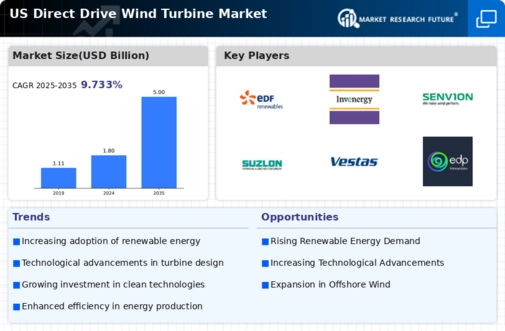Rising Energy Costs
The escalating costs of traditional energy sources are driving interest in the direct drive-wind-turbine market. As fossil fuel prices fluctuate, consumers and businesses are increasingly seeking alternative energy solutions. The direct drive technology, which eliminates the need for a gearbox, offers higher efficiency and lower maintenance costs. This technology can potentially reduce energy costs by up to 20% compared to conventional wind turbines. As energy prices continue to rise, the direct drive-wind-turbine market will likely see increased adoption, particularly in regions where energy costs are a significant concern.. The shift towards renewable energy sources is further supported by the economic benefits associated with direct drive systems, making them an attractive option for energy producers and consumers alike.
Environmental Regulations
Stringent environmental regulations in the US are propelling the direct drive-wind-turbine market forward. As governments implement policies aimed at reducing carbon emissions, the demand for clean energy solutions is intensifying. Direct drive technology, known for its lower environmental impact, aligns well with these regulatory frameworks. The market is witnessing a shift as companies seek to comply with regulations while also capitalizing on the benefits of renewable energy. the direct drive-wind-turbine market will grow as businesses invest in cleaner technologies to meet compliance standards.. This trend is further supported by incentives for renewable energy projects, which can enhance the financial viability of direct drive systems.
Technological Innovations
Innovations in turbine design and materials are enhancing the performance of direct drive-wind-turbine systems. Advances in aerodynamics and lightweight materials are contributing to increased energy output and efficiency. The direct drive-wind-turbine market is benefiting from these technological advancements, which allow for larger turbines capable of generating more power. For instance, the introduction of high-strength composite materials has enabled manufacturers to produce larger rotor blades, improving energy capture. As technology continues to evolve, the market is likely to see a surge in demand for these advanced systems, particularly in areas with high wind potential. The integration of smart technology and IoT in turbine management is also expected to optimize performance and maintenance.
Consumer Awareness and Demand
There is a notable increase in consumer awareness regarding the benefits of renewable energy, which is positively impacting the direct drive-wind-turbine market. As individuals and businesses become more informed about the environmental and economic advantages of wind energy, the demand for direct drive systems is likely to rise. This heightened awareness is fostering a culture of sustainability, where consumers actively seek out clean energy options. the direct drive-wind-turbine market benefits from this trend, as consumers prioritize energy solutions that align with their values.. Additionally, educational initiatives and community engagement efforts are further driving interest in wind energy, creating a favorable environment for the growth of direct drive technology.
Investment in Renewable Energy
The growing investment in renewable energy projects is a key driver for the direct drive-wind-turbine market. With increasing awareness of climate change and the need for sustainable energy solutions, both public and private sectors are channeling funds into renewable initiatives. In 2025, investments in renewable energy in the US are projected to exceed $100 billion, with a significant portion allocated to wind energy. This influx of capital is likely to accelerate the deployment of direct drive technology, which offers advantages such as reduced operational costs and improved reliability. As financial institutions recognize the long-term benefits of investing in renewable energy, the direct drive-wind-turbine market stands to gain substantial momentum.






















Leave a Comment